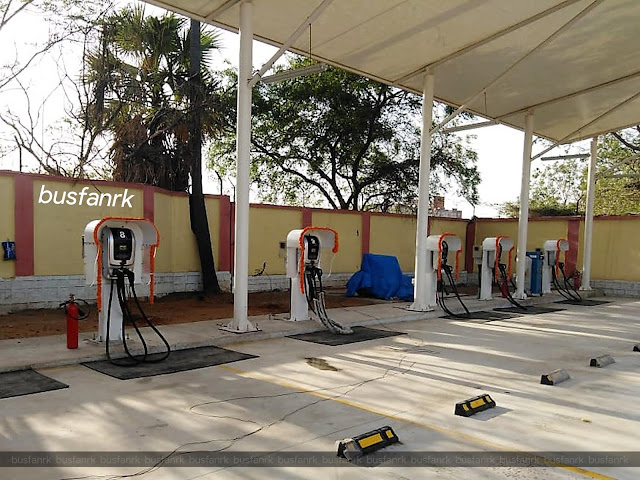With "Sleeper cum Seater" Buses taking over most routes operated by private operators, the State owned Andhra Pradesh State Road Transport Corporation(APSRTC) was loosing a significant amount of potential premium class passengers. In an attempt to attract such passengers, APSRTC inducted "Sleeper cum Seater" buses in its fleet and branded them
Night Rider - A/c Seat Cum Sleeper
Like icing on the Cake, with a touch of it's unmatched safety records APSRTC launched an initial Fleet of Dozen Buses. Of these, Half are 42 Capacity Veera V7 Coaches (20Berths + 22Seats) and the rest are 48 Capacity Veera V7 Coaches (15Berths + 33Seats).
Model
|
Upper Berth
|
Lower Berth
|
Seater
|
42 Capacity(20Berths + 22Seats)
|
Rs. 200/-
|
Rs. 220/-
|
Rs. 171/-
|
48 Capacity(15Berths + 33Seats)
|
Rs. 200/-
|
No Lower Berths
|
Rs. 171/-
|
 |
| A.P.S.R.T.C Night Rider - A/C Seat Cum Sleeper |
These 12 new buses were alloted to 5 different depots across the state and are serving the following 14 Schedules every day :
Depot
|
Route(Origin - Destination)
|
Service no.
|
Sch. Departure
|
Sch. Arrival
|
Amalapuram
|
Amalapuram - BHEL
|
2574
|
20:15
|
08:00
|
Amalapuram - RGIA
|
2562
|
21:00
|
08:15
| |
BHEL - Amalapuram
|
2573
|
19:45
|
07:00
| |
RGIA - Amalapuram
|
2563
|
20:00
|
06:45
| |
Kakinada
|
Kakinada - Tirupati
|
2639
|
17:15
|
06:30
|
Tirupati - Kakinada
|
2640
|
18:15
|
07:05
| |
Kurnool-1
|
Kurnool - Vijayawada
|
6277
|
22:30
|
05:50
|
Vijayawada - Kurnool
|
6278
|
22:00
|
05:20
| |
Vijayawada
|
Vijayawada - Miyapur
|
3599
|
22:45
|
04:45
|
Vijayawada - Miyapur
|
3838
|
23:50
|
05:50
| |
Miyapur - Vijayawada
|
35276
|
10:30
|
17:00
| |
Miyapur - Vijayawada
|
3584
|
13:30
|
20:00
| |
Visakhapatnam
|
Maddilapalem - Tirupati
|
3479
|
14:30
|
07:35
|
Tirupati - Visakhapatnam
|
3480
|
16:15
|
08:10
|
* Schedules as on 14/07/19
 |
| A.P.S.R.T.C Night Rider - A/C Seat Cum Sleeper |
 |
| A.P.S.R.T.C Night Rider - A/C Seat Cum Sleeper |
The concept was a success in no time and Statistics prove that these Riders are presently reaping the Highest margins after the prestigious AMARAVATIs. In few instances Night Riders are outperforming AMARAVATIs too w.r.t margin per/Km. Considering the Success of the product with a constant O.R of 80+ the corporation is now planning to introduce more number of Night Riders into the Fleet.
Depot
|
Buses
|
Kmpl
|
Earnings per/Km
|
Cost per/km
|
Margin per/Km
|
Amalapuram
|
4 Buses
48 Capacity(33Seats + 15Berths)
|
3.7
|
Rs. 67.29
|
Rs. 42.97
|
Rs. 24.32
|
Kakinada
|
2 Buses
42 Capacity(22Seats + 20Berths)
|
3.53
|
Rs. 67.29
|
Rs. 46.49
|
Rs. 20.80
|
Kurnool-1
|
2 Buses
48 Capacity(33Seats + 15Berths)
|
3.78
|
Rs. 65.13
|
Rs. 51.51
|
Rs. 13.62
|
Vijayawada
|
2 Buses
42 Capacity(22Seats + 20Berths)
|
3.76
|
Rs. 72.27
|
Rs. 43.59
|
Rs. 28.68
|
Visakhapatnam
|
2 Buses
42 Capacity(22Seats + 20Berths)
|
3.49
|
Rs.65.15
|
Rs. 45.75
|
Rs. 19.4
|
* All Details are as upto May’19(3Months of Launch)
 |
| A.P.S.R.T.C Night Rider - A/C Seat Cum Sleeper of Vijayawada Depot en route Miyapur - Vijayawada. |
 |
| A.P.S.R.T.C Night Rider - A/C Seat Cum Sleeper |
Have a HAPPY & SAFE Journey!!
LOVE of Z - Celebrating Public Transport

















